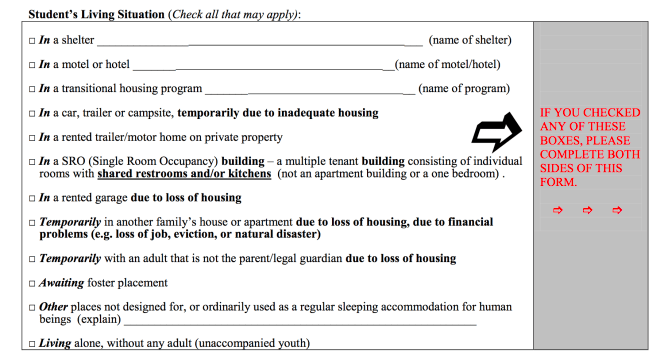Last week, in response to the problem of homelessness among youth in the Los Angeles Unified School District (LAUSD), the school board approved a resolution directing Superintendent Austin Beutner to "explore innovative solutions to provide permanent and or interim housing for homeless students and their families," advocate for the expansion of Section 8 voucher program, and lobby for more federal funds to be allocated toward programming for homeless students.
Specifically, the resolution also directs Beutner to report back to the board within six months on the feasibility of
- Allowing overnight parking for homeless families living in their vehicles as part of the Safe Parking L.A. Program (including security and supportive services, such as maintenance);
- Providing overnight shelter, meals, and wraparound supports for homeless families throughout the year or, at minimum, during winter and summer recesses;
- Converting or building new buildings that provide temporary or permanent shelter for homeless youth or families;
- Converting or building permanent shared housing using the FlyawayHomes shipping container apartment model seen in South L.A.;
- Expanding the wraparound supports provided to homeless students and families and supporting homeless students as they transition to local institutions of higher education in areas like housing, transportation, food stability, mental health supports, etc.;
- Assessing the effectiveness of our current Homeless Education Program and supports, including its impact on student learning;
- Exploring the possibility of expanding the District’s Homeless Education Program;
- Assessing ways to better support school site homeless liaisons;
- Assessing the effectiveness of the annual Student Residency Questionnaire.
While homelessness has long been an issue within LAUSD, the need to act now was underscored by the realization that the problem was much greater than previously thought. The numbers jumped from 11,481 students experiencing homelessness in 2015-16 to 17,258 in 2016-17 - an increase of approximately 50 percent. As of 2017, the highest percentage of homeless students were found in the East San Fernando Valley. South Bay, downtown, and East L.A. follow closely behind.
Such a significant jump may have more to do with the doubling of staff addressing homelessness in 2016 and the district's improved ability to track homelessness than to changes in students' circumstances.
Yet officials worry that it is still not an accurate count.
Homelessness is essentially self-reported when families complete the district's Student Residency Questionnaire at the beginning of the year. Those living in a shelter, a motel/hotel, vehicle, at a campsite, in transitional housing, or even temporarily with another family are considered homeless. But parents may not answer those questions accurately in an attempt to hide their status, or their circumstances may change over the course of the year.
Either way, the alarm bells that such a high number of homeless students should set off should have thwarted any opposition to the preparation of a feasibility study. Especially since the resolution calls for any concrete steps LAUSD takes down the line toward housing or service provision to be done in collaboration with public and private partners and using bond funds meant to serve homeless populations (limiting the impact on LAUSD's budget as well as its operational capacities). And also because mitigating some of the consequences of homelessness for students could improve outcomes, as the L.A. School Report noted:
Research shows [homeless] students are eight times more likely than their peers to repeat a grade and twice as likely to score lower on standardized tests. About 23 percent of homeless youth in L.A. Unified also miss 10 percent or more of the school year — nearly twice the district average, according to the California Department of Education.
But because this is Los Angeles, the very first four speakers to offer public comment were people from well-to-do Woodland Hills who were under the mistaken impression that LAUSD already had plans to put a homeless shelter on the grounds of Oso Elementary, a long-standing eyesore.
Although the residents had apparently only heard this information the night before, they had quickly rallied so they could make the case that having homeless kids on LAUSD properties would attract criminal elements and drug use/sales, while potentially stealing valuable parking space from residents and... giving safe harbor to rapists and murderers, as Guy Ziv's remarks about his own shelter experience in Israel seemed meant to imply.
Even boardmember George McKenna appeared unclear as to what the objective of the resolution was. He rambled at great length about a range of unrelated topics, including his inability to understand how a wealthy celebrity might suffer from depression and his fear that resolving homelessness would attract more homeless people. Ultimately, his greatest concern appeared to be that little would come of the resolution beyond making the school board feel good for having made it.
Resolution author Kelly Gonez reassured listeners that she took the issue of homelessness and the well-being of all students and their families seriously. And that while the hope was that concrete action would indeed result from the resolution, the current aim was solely to assess the feasibility of any and all options LAUSD had at its disposal to assist its homeless students. There were no plans to build anything at Oso Elementary or elsewhere.
The reason LAUSD had moved in this direction, said board member and co-sponsor of the resolution Mónica García, was that schools play a significant role in community wellness. And while their mission might be one of education, carrying out that mission sometimes required reducing the barriers students faced to accessing that education.
LAUSD was already active in providing homeless youth with counseling, backpacks, school supplies, and transportation, both García and Gonez said, but the increase in homelessness was putting a strain on those limited resources. Partnering with groups equipped with the staff, knowledge, and resources to address homelessness would help take that burden off LAUSD.
The resolution, García continued, only asked them to be more available to deepening the partnerships and programs the district already relies on and to bringing in new partners and funding sources that could help LAUSD serve students more comprehensively.
"We've been part of answering the call," she said of the school district's efforts to meet a wide range of student needs. But "the call is louder today. And my interest in supporting the work that our folks do on the ground is about raising it to another level."
* * *
McKenna ultimately abstained from voting on the resolution, while Richard Vladovic was the only board member to vote against it. Find the resolution here. Video of the discussion of the resolution can be found here, starting at 57:10.






